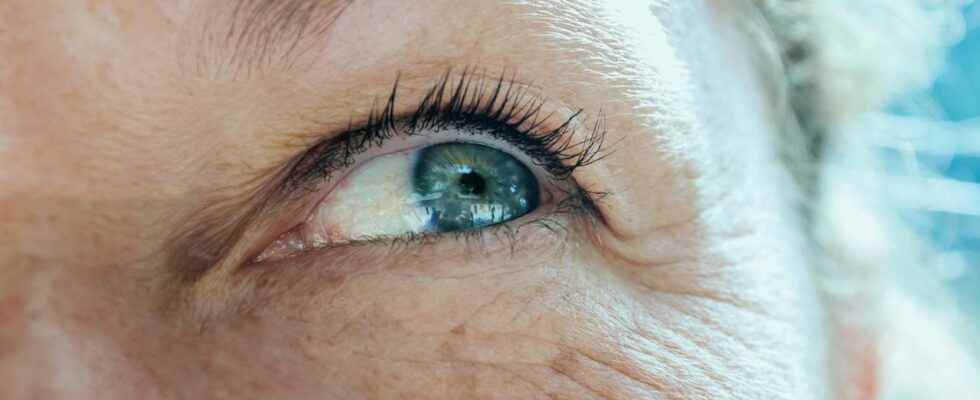You will also be interested
[EN VIDÉO] Kezako: Can we really trust our eyes? The human eye can differentiate nearly eight million shades of color. However, this organ so advanced gives little information to our cortex to create an image. So what exactly happens when we see? Unisciel and the University of Lille 1 explain to us, with the Kézako program, the functioning of this surprising organ.
The eyes are the mirror of soul. They reflect our emotions and feelings. And according to researchers from thebelfast university (Northern Ireland), it is even possible to read information relating to the health of our brain. Will peripheral retinal imaging soon improve the management of Alzheimer’s disease or others neurodegenerative diseases ?
To find out, the researchers analyzed the retinas of patients with Alzheimer’s disease using ultra-widefield imaging technology. A technology that is simple, rapid, well tolerated and less expensive than scintigraphs cerebral. They were thus able to note that the occurrence of drusen is more marked in these patients than in healthy people.
Markers on the retina
Remember that drusen are small yellow “spots” that correspond to deposits of fat, proteinand of minerals . The drusen are a ” symptom» classic of aging and are generally harmless. Except when their number becomes too large.
Another observation is that patients with Alzheimer’s disease have larger vessels near the optic nerve, but which thin out more quickly than those of control patients towards the periphery of the retina. What makes more difficult the influx of nutrients and oxygen. Markers that the researchers describe as easy to identify, even in the very early stages of the development of the disease. A discovery that could make it possible to identify and judiciously support high-risk groups.
Examine the brain… by looking deep into the eyes
It is said that the eyes are the mirror of the soul. They are also that of brain . According to the results of a study, one couldto scan retinal know the state of health of the brain. How? ‘Or’ What ? Problems with the blood vessels of the eye can be a sign of vascular disease, and this organ is particularly sensitive to it.
Article by Janlou Chaput published on 03/22/2012
The brain is a central organ. Good health is therefore essential. Sometimes silent stroke can be the cause of a decline in cognitive abilities. Those accidents vascular deprive some neurons sufficient blood supply (due to artery blockage or breakthrough: ischemia). No longer having access to oxygen and nutrients, these nerve cells die and are no longer able to carry out their function.
Problem: the brain is not the easiest organ to access, enclosed in a brain cavityprotective, therefore difficult to observe. How to estimate the good health of the brain? According to the work of researchers at the University of California (san francisco) and published in Neurology, there is a connection between the state of the blood vessels of the retina and those of the brain. It would therefore suffice to look at the vascular damage in the background of theeyes to estimate the risk of accidents of the same order in the brain.
Look into each other’s eyes
Their research is based on the results obtained from 511 postmenopausal women, aged 65 and over (average age: 69) followed for ten years. Each year, they carried out tests of memory and verbal expression, both oral and written. Four years after the start of follow-up, retinal health was assessed. In the eighth year, a scanner made it possible to ascertain the state of the brain .
What were the findings? Of the panel of women, 39 (or 7.6%) had retinopathies, in this case a retina with swollen vessels, leaking or with abnormal growth. On average, their thinking and memory test scores were 10-15% lower than the other women. The scan also revealed that the volume areas ischemicwas 47% higher at the brain level in these same subjects compared to the rest of the population studied, and that it even rises to 68% at the level of the parietal lobe. On the other hand, none atrophy cerebral is observed and during tests visualsnothing distinguishes the two groups of women.
Eyes and brain: in what order?
Thus, this work confirms previous work, which also showed that retinopathies could be used as markers to estimate the risks of cerebrovascular diseases.
Mary Hann, one of the authors of the study, is delighted. ” This can be very useful if a simple retinal scan gives us an early indication of people potentially at risk for problems with their brain health and functioning. » A way to know the status of blood vessels by a non-invasive and rapid method.
Be careful, however, not to take too many shortcuts: retinopathy should not be systematically associated with cognitive deficit . This technique described here only makes it possible to estimate a risk of presenting disorders in the blood circulation of the brain, but in no way to affirm that they have occurred or that they will occur.
Precisely, the continuation of the program consists in also determining the order of appearance of these disorders. Do they first affect the brain before manifesting at the level ocular? Is it the reverse? Is it random? New studies will one day probably provide the right answer.
In addition to the workshops offered throughout France by the Society of Neurosciences, at the origin of Brain Week, Futura highlights the latest scientific advances concerning our ciboulot. Cognition, psychology or even unusual and extraordinary stories, a collection ofitemsof questions answers and of podcast to be found all this week under the tag “brain week» and on our social networks!
Interested in what you just read?
